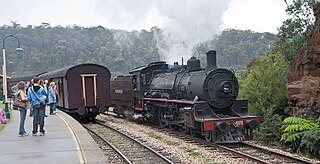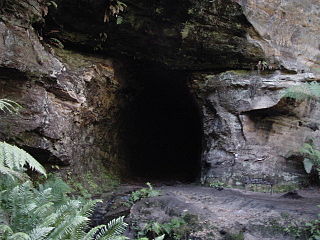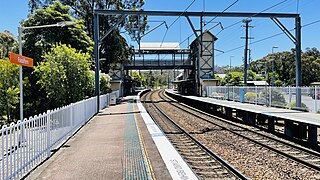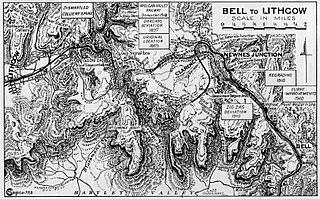
Lithgow is a town in the Central Tablelands of New South Wales, Australia and is the administrative centre of the City of Lithgow local government area. It is located in a mountain valley named Lithgow's Valley by John Oxley in honour of William Lithgow, the first Auditor-General of New South Wales.

The Zig Zag Railway is an Australian heritage railway, situated near Lithgow, New South Wales. It was opened by the not-for-profit Zig Zag Railway Co-op as an unpaid volunteer-staffed heritage railway in October 1975, using the alignment of the Lithgow Zig Zag line that formed part of the Main Western line between 1869 and 1910. The line climbs the western flank of the Blue Mountains, using railway zig zags to gain height.

The South Coast Railway is a commuter and goods railway line from Sydney to Wollongong and Bomaderry in New South Wales, Australia. Beginning at the Illawarra Junction, the line services the Illawarra and South Coast regions of New South Wales.

Wolgan Valley is a small valley located along the Wolgan River in the Lithgow Region of New South Wales, Australia. The valley is located approximately 32 kilometres (20 mi) north of Lithgow and 150 kilometres north-west of Sydney. Accessible by the Wolgan Valley Discovery Trail from the Castlereagh Highway, the road travels through the valley leading onto the historical village of Newnes and its extensive industrial ruins.

The Glowworm Tunnel is a disused railway tunnel between Lithgow, New South Wales and Newnes, New South Wales, Australia. It is notable for its resident glow-worms, the bioluminescent larvae of Arachnocampa richardsae, a type of fungus gnat.

Newnes, an abandoned oil shale mining site of the Wolgan Valley, is located in the Central Tablelands region of New South Wales, Australia. The site that was operational in the early 20th century is now partly surrounded by Wollemi National Park. The settlement was originally built by the Commonwealth Oil Corporation.

The Lapstone Zig Zag was a zig zag railway built between Emu Plains and Blaxland stations on the Main Western Line of New South Wales in Australia. Constructed between 1863 and 1865 to overcome an otherwise insurmountable climb up the eastern side of the Blue Mountains, the zig zag and associated Knapsack Viaduct, a sandstone arch viaduct, were designed by John Whitton, Engineer-in-Charge of New South Wales Government Railways, and were built by William Watkins. The zig zag was listed on the Blue Mountains local government heritage register on 27 December 1991; while the adjacent Knapsack Viaduct was listed on the New South Wales Heritage Database on 2 April 1999. The Lapstone Zig Zag was the world-first Zig Zag constructed on any main-line railway.

Fassifern railway station is located on the Main Northern line in New South Wales, Australia. It serves the City of Lake Macquarie suburb of Fassifern, opening in 1888.

Zig Zag railway station is located on the New South Wales Main Western Line. It was originally built in April 1878 and closed in 1910 due to the opening of the Ten Tunnels Deviation which bypassed the original site of the station. The station was not rebuilt until 1959 when a new station was built alongside the 1910 alignment in a similar location to the 1878 station.
The Main Western Railway is a major railway in New South Wales, Australia. It runs through the Blue Mountains, and Central West regions. It is 825 kilometres (513 mi) with 484 kilometres (301 mi) operational & 341 kilometres (212 mi) under construction & repairs.

The City of Lithgow is a local government area in the Central West region of New South Wales, Australia. The area is located adjacent to the Great Western Highway and the Main Western railway line.
Clarence is a railway station on the Blue Mountains section of the Main Western railway line in New South Wales, Australia. It opened in 1874 on the original alignment from Bell to the Clarence Tunnel. With the opening of Dargan's Deviation, it was rebuilt to its second location.

The Newnes railway line is a closed and dismantled railway line in New South Wales, Australia. The line ran for 32 mi (51 km) from the Main Western line to the township of Newnes. Along the way, it passed through a tunnel now known as the Glowworm Tunnel, because it is famous for its glow-worms. The tunnel is now contained within the Wollemi National Park.
Clarence is a location in New South Wales, Australia. It was originally a railway outpost on the original railway line across the Blue Mountains, but by 1908 when Clarence was used as headquarters for the Ten Tunnels Deviation works, the town population had flourished to over 5,000 residents, the majority being the navvies employed on the deviation works. When the deviation was opened in 1910, the town population quickly fell, despite a new platform built on the new deviation.

The Lithgow Zig Zag is a heritage-listed former zig zag railway line built near Lithgow on the Great Western Line of New South Wales in Australia. The zig zag line operated between 1869 and 1910, to overcome an otherwise insurmountable climb and descent on the western side of the Blue Mountains. It was designed by John Whitton and built from 1863 to 1869 by Patrick Higgins as contractor. It is also known as the Great Zig Zag Railway and Reserves and Zig Zag Railway. The property is owned by Department of Planning and Infrastructure. It was added to the New South Wales State Heritage Register on 2 April 1999.
The Dargans Deviation was a section of the original Main Western railway line over the Blue Mountains in New South Wales, Australia. It was constructed from 1896 to 1897 in an effort to ease the grades of the original alignment from before Newnes Junction to Clarence, with a ruling grade of 1 in 60. Along with a few crossing loops, it enabled much longer trains to use the line. After the construction of the Ten Tunnels Deviation, it was abandoned.

The Ten Tunnels Deviation is a heritage-listed 9.2-kilometre (5.7 mi) section of the Main Western Line between Newnes Junction and Zig Zag stations in Lithgow, New South Wales, Australia. It was designed and built by the New South Wales Government Railways and built from 1 June 1908 and 16 October 1910. It is also known as Great Zig Zag Railway deviation tunnels and Bell to Zig Zag Ten Tunnel Railway Deviation. It was added to the New South Wales State Heritage Register on 2 April 1999.
The Glenbrook deviation was a section of track on the Main Western line from the first Knapsack Viaduct to old Glenbrook station in the Blue Mountains of New South Wales, Australia. The approximately five-mile-long (eight-kilometre) deviation was constructed from 1891 to 1892 and replaced the Lapstone Zig Zag. The deviation was closed in 1913 when it was replaced by the second Glenbrook deviation and the second Glenbrook Tunnel, that continues to carry the Main Western line today.
The Glenbrook deviation is a section of track on the Main Western line from Emu Plains to Blaxland stations in the Blue Mountains of New South Wales, Australia. The approximately seven-mile-long (eleven-kilometre) double-track deviation was constructed from 1911 to 1913 and replaced the single-track first Glenbrook deviation and the first Glenbrook Tunnel.













